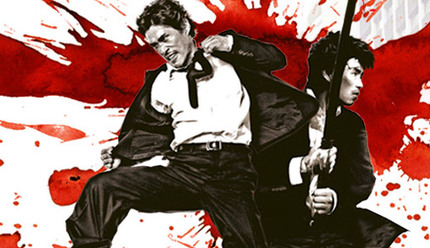THE CITY OF VIOLENCE Review

The KOFFIA (Korean Film Festival in Australia) starts next week in Sydney. The Unjust is Seung-wan Ryoo's newest film and will be screening on opening night at KOFFIA with director in attendance! I caught his second last feature The City of Violence which is out on DVD, and it is a lovely precursor for the cinematic delights to come at KOFFIA, hold on tight!
Detective Tae-su (Doo-hong
Jung), returns to his hometown for his child hood friend Wang-jae's (Kil-Kang
Ahn) funeral. At the funeral he runs into his old gang; Pil-ho (Beom-su Lee),
Dong-hwan (Seok-yong Jeong) and Seok-hwan (Seung-wan Ryoo). Suspecting something
odd about Wang-jae's death, Tae-su and Seok-hwan start investigating in their
own unique way, and uncover a dodgy land development project that hits close to
home and may tie in to the death of their friend.
The City of Violence is a lot of things; it is homage to Shaw Brothers, Tarantino and the film The warriors - it is a mesh of violence, choreography, a fusion of life and death and chaos, rivalry, friendships and betrayal. Instantly we witness Wang-Jae's death, shadow play on the wall reflects his demise off screen. Cut to the present and director Seung-wan Ryoo depicts an embarrassing display of professionalism. It is chaos in the police office, shirtless criminals lie cuffed to the table, a cop kicks one out of the way to grab something and the trend that the law lacks order is prevalent here, something he drives home in his latest feature The Unjust.
Detective Tae-su leaves the busy and unorganized Seoul to visit the smaller city he called home. When he meets his childhood friends at the funeral the narrative really picks up. It is a city of violence - a real estate issue is responsible for the escalation of said violence, and as the two protagonists beat everyone they can to learn the truth, the narrative uses the past to explain the present situation. Initially, a reminisced fight scene from the past accompanied by catchy 80's Korean pop music connects to the present day. They lament on their lost friend, bonding over violence and past transgressions. The effects here are interesting, flashing back to the present whenever a young boy from the past is on screen, in order to identify who is who when they were younger.
In fact The City of Violence is filled with clever and unique cinematography and camera effects. The camera rambles throughout the city, jump cuts and transitions are presented stylishly, during fight scenes old style crane shots are used, dramatic zooms and some long shots are also utilized well. These diverse styles accompany the unexpected ultra-bright comic violence and insane street choreography which appears goofy at times due to the caricatures on screen. These include a silent henchman with crazy hair and all manners of street gangs identified by their matching baseball, B-boy or school uniforms that get into a break-dance brawl, interspersed by flurries of violence. These are often contrasted with what the protagonists are wearing, usually something generic, but the standout brawl at the end has them in suave black suits fighting scores of white suited villains, essentially all of these elements (costume, choreography, camera) are an exercise in style, and although rough around the edges, they enhance the genre and narrative and provides a fun twist to each fight.
This fluid style of violence employs a stop and start method which works to highlight the progressive nature of each conflict. It is easy to enjoy the silliness of each fight, but there is also a sinister undercurrent in the narrative that brings with it some warped black humor, in particular the interrogations and torture scenes the antagonist inflicts on essentially innocent people. The constant fighting and extremely tragic turn of events leads Tae-su and co to an ultra-stylish showdown, reminiscent of House of Blue Leaves of Kill Bill fame. This scene is more an alternate version of that, employing the same stylistic devices and camera work, fights with loads of uniformed bad guys and a violent climax to end proceedings.
The City of Violence is a funny, ultra stylish and messily sentimental genre flick. It is in a lot of ways very unique and really enjoyable. It is ultimately a tale of soulful revenge and is not perfect, but it is definitely a testament of director Ryoo's ability to brilliantly portray absolute scatter-shot chaos on screen, with hyper bursts of kinetic violence and wicked humor. It is a companion to The Unjust thematically and spiritually and ending the film with profanity is a master stroke of cynical pretension.







